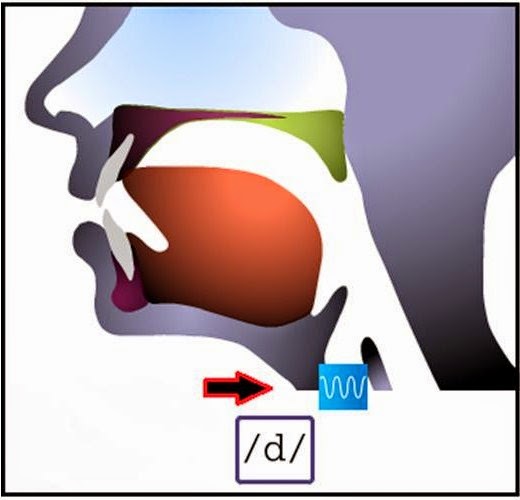The field of articulatory phonetics is a subfield of phonetics. In studying articulation, phoneticians explain how humans produce speech sounds via the interaction of different physiological structures.
The two classes of sounds
Sounds of all languages fall under two categories: Consonants and Vowels.
Consonants
All consonants may be classified as either voiced or voiceless. In articulating a voiced consonant, the vocal cords are vibrating. (The vibration may easily be felt by gripping the larynx--the "Adam's apple"--between the fingers and the thumb while articulating the consonant.) In articulating an unvoiced consonant, the vocal cords are not vibrating.
Present-Day English has several consonant pairs that are articulated alike except that one is voiced and the other is unvoiced. Some examples are the phoneme spelled b in bat (voiced) and the phoneme spelled p in pat (unvoiced); the phoneme spelled d in dab (voiced) and the phoneme spelled t in tab (unvoiced); the phoneme spelled th in this (voiced) and the phoneme spelled th in thistle (unvoiced).
Consonants may also be classified according to the manner of articulation and the point of articulation: that is, how and where the flow of air is stopped or impeded when the consonant is articulated. Thus, we get the following systems of classification.
Present-Day English has several consonant pairs that are articulated alike except that one is voiced and the other is unvoiced. Some examples are the phoneme spelled b in bat (voiced) and the phoneme spelled p in pat (unvoiced); the phoneme spelled d in dab (voiced) and the phoneme spelled t in tab (unvoiced); the phoneme spelled th in this (voiced) and the phoneme spelled th in thistle (unvoiced).
Consonants may also be classified according to the manner of articulation and the point of articulation: that is, how and where the flow of air is stopped or impeded when the consonant is articulated. Thus, we get the following systems of classification.
Vowels
Nasal vowel / Oral vowel
Previous Vowel / Later Vowel
Rounded vowel / Unrounded vowel
Open vowel / Closed vowel
Place or point of articulation
One of the differences between consonants and vowels is that when we articulate vowels, the airstream flows out freely along the middle of the tongue. When we articulate consonants on the other hand, we make some kind of obstruction in the speech organs, which prevents the air from flowing out freely. These obstructions may be made with for example some part of the tongue touching or approaching the roof of the mouth, or with the lips touching each other or the upper teeth, or by making an obstruction between the vocal chords. The parts of the speech organs which are involved in articulating consonants (tip of the tongue, lips, palate, teeth, vocal chords etc.) are called articulators.
Manner of articulation
Manners of articulation describe the kind of obstruction that takes place in articulation of the consonant in question.
Stops / Plosives / Consonants
Stops or plosives are consonants formed by completely stopping the flow of air somewhere in the vocal apparatus, and then releasing the air. Since the sudden release of the pent-up air creates a small explosive sound, stops are also called plosives. Stops may be voiced (vocal cords vibrating during the articulation of the stop) or voiceless (vocal cords not vibrating during the articulation of the stop). Here is a list of the stops in Present-Day English.
1. /p/ (the phoneme spelled p in pat): voiceless bilabial stop/plosive.
2. /b/ (the phoneme spelled b in bat): voiced bilabial stop/plosive.
3. /t/ (the phoneme spelled t in tot): voiceless alveolar stop/plosive.
4. /d/ (the phoneme spelled d in dot): voiced alveolar stop/plosive.
5. /k/ (the phoneme spelled c in cap): voiceless velar stop/plosive.
6. /g/ (the phoneme spelled g in gap): voiced velar stop/plosive.
The parts of the human vocal apparatus
that are relevant to the description of English phonemes




Comentario » Comments »»» Blogger Facebook Disqus